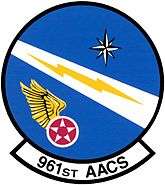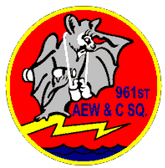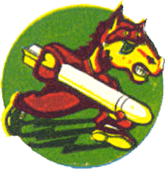961st Airborne Air Control Squadron
The 961st Airborne Air Control Squadron (961 AACS) is part of the 18th Wing at Kadena Air Base, Japan. It operates the E-3 Sentry aircraft conducting airborne command and control missions.
| 961st Airborne Air Control Squadron | |
|---|---|
| Active | 1941-1945; 1954-1969; 1979-Present |
| Country | United States |
| Branch | United States Air Force |
| Type | Airborne Command and Control |
| Part of | Pacific Air Forces 5th Air Force 18th Wing 18th Operations Group |
| Garrison/HQ | Kadena Air Base |
| Decorations | Distinguished Unit Citation Air Force Outstanding Unit Award |
| Commanders | |
| Notable commanders | William Crumm Colonel Caleb Lutter |
| Insignia | |
| 961st Airborne Air Control Squadron emblem (approved 2 March 1981)[1] |  |
| 961st Airborne Early Warning & Control Sq emblem |  |
| 61st Bombardment Squadron emblem (approved 15 May 1942)[2] |  |
Mission
Provide airborne command and control, long-range surveillance, detection and identification information for commanders in support of U.S. goals.[3]
History
World War II
Established in November 1940 as a B-17 Flying Fortress Heavy Bombardment squadron organized at Fort Douglas, Utah; assigned to the GHQ Air Force Northwest Air District at Geiger Field, Washington where the squadron flew training missions and also reconnaissance missions along the Northwest Pacific Coast. After the Pearl Harbor Attack, became first an Operational Training Unit (OTU) at Davis-Monthan Field, Arizona, later converting to a B-24 Liberator Replacement Training Unit (RTU).
B-29 Superfortress operations against Japan
Re-designated on 1 April 1944 as a B-29 Superfortress Very Heavy bombardment squadron. When training was completed moved to North Field Guam in the Mariana Islands of the Central Pacific Area in January 1945 and assigned to XXI Bomber Command, Twentieth Air Force. Its mission was the strategic bombardment of the Japanese Home Islands and the destruction of its war-making capability.
Flew "shakedown" missions against Japanese targets on Moen Island, Truk, and other points in the Carolines and Marianas. The squadron began combat missions over Japan on 25 February 1945 with a firebombing mission over Northeast Tokyo. The squadron continued to participate in wide area firebombing attack, but the first ten-day blitz resulting in the Army Air Forces running out of incendiary bombs. Until then the squadron flew conventional strategic bombing missions using high explosive bombs.
The squadron continued attacking urban areas with incendiary raids until the end of the war in August 1945, attacking major Japanese cities, causing massive destruction of urbanized areas. Also conducted raids against strategic objectives, bombing aircraft factories, chemical plants, oil refineries, and other targets in Japan. The squadron flew its last combat missions on 14 August when hostilities ended. Afterwards, its B 29s carried relief supplies to Allied prisoner of war camps in Japan and Manchuria
Squadron remained in Western Pacific, although largely demobilized in the fall of 1945. Some aircraft scrapped on Tinian; others flown to storage depots in the United States. Inactivated as part of Army Service forces at the end of 1945.
Cold War
The 961st flew radar surveillance missions along East Coast of the United States from, 18 December 1954 – 31 December 1969. The squadron assisted with the coverage of salvage operations of downed Korean Air Lines Flight 007, 1 –10 September 1983. It has served as the airborne command and control for the commander, United States Pacific Command and supported US forces counter air interdiction, close air support, search and rescue, reconnaissance, and airlift operations since 1980.[1]
Operations
- World War II[1]
- Combat Operations: Conducted bombardment missions against Japan, c. 6 Apr-14 Aug 1945.
- Campaigns: World War II: Western Pacific; Air Offensive, Japan.
- Decorations: Distinguished Unit Citations: Japan, 10 May 1945; Tokyo and Yokohama, Japan, 23–29 May 1945.
Lineage
61st Bombardment Squadron
- Constituted as the 61st Bombardment Squadron (Heavy) on 20 November 1940
- Activated on 15 January 1941
- Inactivated on 1 April 1944
- Redesignated 61st Bombardment Squadron, Very Heavy and activated on 1 April 1944
- Inactivated on 27 December 1945
- Consolidated with the 961st Airborne Warning and Control Squadron as the 961st Airborne Warning and Control Squadron on 19 September 1985[1]
961st Airborne Air Control Squadron
- 961st Airborne Early Warning and Control Squadron (1954–1979)
- 961st Airborne Warning and Control Support Squadron (1979–1982)
- 961st Airborne Warning and Control Squadron (1982–1994)
- 961st Airborne Air Control Squadron (1994–Present)[1]
Assignments
- 39th Bombardment Group, 15 Jan 1941-1 Apr 1944
- 39th Bombardment Group, 1 Apr 1944-27 Dec 1945
- 551st Airborne Early Warning and Control Wing (1954–1969)
- 552d Airborne Warning and Control Division (1979–1985)
- 28th Air Division (1985–1990)
- 313th Air Division (1990–1991)
- Attached: 5th Air Force (1990–1991)
- 18th Wing (1991–Present)[1]
Bases stationed
- Fort Douglas, Utah, 15 Jan 1941
- Geiger Field, Washington, 2 Jul 1941
- Davis-Monthan Field, Arizona, 5 Feb 1942-1 Apr 1944
- Smoky Hill Army Air Field, Kansas, 1 Apr 1944
- Dalhart Army Air Field, Texas, 27 May 1944
|
Aircraft
- B-17 Flying Fortress (1941–1942)
- B-24 Liberator (1942–1944)
- B-29 Superfortress (1944–1945)
- C-121 Constellation (1955–1969)
- E-3 Sentry (1979–Present)[1]
References
Notes
- Robertson, Patsy (2 April 2014). "Factsheet 961 Airborne Air Control Squadron (PACAF)". Air Force Historical Research Agency. Retrieved August 18, 2014.
- Maurer, Combat Squadrons, pp. 236-237
- 18 OG Fact Sheet Archived 2016-03-03 at the Wayback Machine
Bibliography
- Maurer, Maurer, ed. (1982) [1969]. Combat Squadrons of the Air Force, World War II (PDF) (reprint ed.). Washington, DC: Office of Air Force History. ISBN 0-405-12194-6. LCCN 70605402. OCLC 72556.
- 18th Operations Group Fact Sheet

